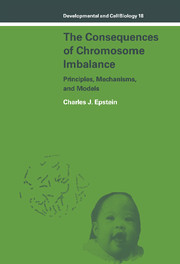Book contents
- Frontmatter
- Contents
- Preface
- Glossary
- PART I INTRODUCTION
- PART II CLINICAL OBSERVATIONS
- PART III THE THEORETICAL MECHANISMS AND ISSUES: THE PRIMARY AND SECONDARY EFFECTS OF ANEUPLOIDY
- 4 Gene dosage effects
- 5 Metabolic pathways, transport systems, and receptors
- 6 Regulatory systems
- 7 Assembly of macromolecules, cellular interactions, and pattern formation
- 8 Type and countertype
- 9 Nonspecific effects of aneuploidy
- PART IV EXPERIMENTAL SYSTEMS FOR THE STUDY OF MAMMALIAN AND HUMAN ANEUPLOIDY
- PART V THREE MAJOR CLINICAL PROBLEMS OF HUMAN ANEUPLOIDY
- PART VI CONCLUSION
- Appendix: Standard karyotypes of man and mouse and human cytogenetic nomenclature
- References
- Index
9 - Nonspecific effects of aneuploidy
Published online by Cambridge University Press: 14 October 2009
- Frontmatter
- Contents
- Preface
- Glossary
- PART I INTRODUCTION
- PART II CLINICAL OBSERVATIONS
- PART III THE THEORETICAL MECHANISMS AND ISSUES: THE PRIMARY AND SECONDARY EFFECTS OF ANEUPLOIDY
- 4 Gene dosage effects
- 5 Metabolic pathways, transport systems, and receptors
- 6 Regulatory systems
- 7 Assembly of macromolecules, cellular interactions, and pattern formation
- 8 Type and countertype
- 9 Nonspecific effects of aneuploidy
- PART IV EXPERIMENTAL SYSTEMS FOR THE STUDY OF MAMMALIAN AND HUMAN ANEUPLOIDY
- PART V THREE MAJOR CLINICAL PROBLEMS OF HUMAN ANEUPLOIDY
- PART VI CONCLUSION
- Appendix: Standard karyotypes of man and mouse and human cytogenetic nomenclature
- References
- Index
Summary
In the previous chapters in Part III, I considered a variety of ways by which changes in gene dosage can effect alterations in metabolism, regulation, cellular structure, and pattern formation. In each instance, the attempt was made to demonstrate how a 50% increase or decrease in gene product could produce a characteristic effect based on the function of the product in question. The relationship between the change in gene number and the phenotypic change or changes that ultimately resulted was regarded as a specific one. In some cases the relationship might be a direct one, but in others the actual pathway between genetic imbalance and phenotype might involve several steps and be difficult to trace.
However, not everyone shares this belief in the specificity of aneuploid effects. It is appropriate, therefore, to consider the arguments made for the existence of nonspecific effects, effects which are not wholly a product of the particular loci that are unbalanced but derive from a more general perturbation in genetic structure or balance.
Regulatory disturbance
Mention has already been made of the possible major role of regulatory disturbances, as proposed, for example, by Krone and Wolf (1972) and by Vogel (1973), to explain the effects of aneuploidy. These effects would not need to be nonspecific if we were dealing with the imbalance of specific regulatory loci, no matter how many structural loci they interacted with.
- Type
- Chapter
- Information
- The Consequences of Chromosome ImbalancePrinciples, Mechanisms, and Models, pp. 174 - 204Publisher: Cambridge University PressPrint publication year: 1986



